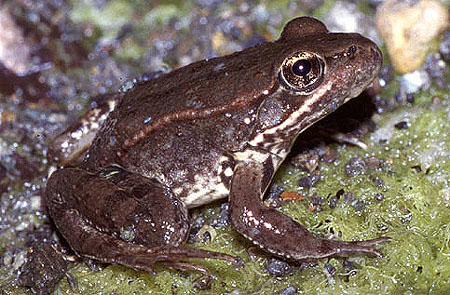Red-Legged Frog Lawyers Up
Hope for Celebrated Jumper

The red-legged frog is one of literature’s most lasting icons, yet most people would be hard pressed to identify this rather unassuming little amphibian. Travel to Calaveras County, California, however, and it’s a different story. That is where Mark Twain’s first famous yarn, “The Celebrated Jumping Frog of Calaveras County,” is set, starring the red-legged frog.
But you don’t have to travel to Calaveras to see the red-legged frog. Native to California, it can be found as far south as Baja. It was once so common that it was thought of as a tasty meal. Now it’s estimated that these frogs are gone from 70 percent of their former range, and that their population has dropped by as much as 90 percent. Like many species, the red-legged frog has suffered from habitat destruction, in particular the crucial wetlands it needs to breed and survive. Competition from the larger, nonnative bullfrogs has also taken its toll.
Besides being a vital part of the food chain for predators like the endangered San Francisco garter snake, the red-legged frog serves as a biological indicator. Frogs breathe through their skin and are consequently very sensitive to pollutants in the water. One way to judge how a body of water is doing is to look at the population of frogs within.
In December 2010, the Center for Biological Diversity announced its intention to sue both the U.S. Fish and Wildlife Service and the Environmental Protection Agency for not acting when they learned of over 60 pesticides present in California that were harmful to the frogs.
While the fate of the red-legged frog isn’t exactly clear, things are looking up. Conservationists have fought hard to get a designated critical habitat for the frog, but it wasn’t until March 2010 that they were truly successful, when the U.S. Fish and Wildlife Service set aside 1.6 million acres as critical habitat. The ruling went into effect in April 2010. The acres stretch across 27 counties, including Santa Barbara.
Two other attempts had been made to secure a place for the frog, but the first (aiming for over 4 million acres of critical habitat) was blocked by a builders group, and the second saw habitat actually decreased by Julie MacDonald, the Department of the Interior’s former deputy assistant secretary for Fish and Wildlife and Parks, who was later found to be working with lobbyists and forcing scientists to change their findings and conclusions.



